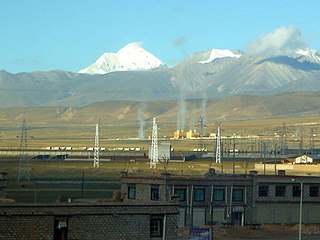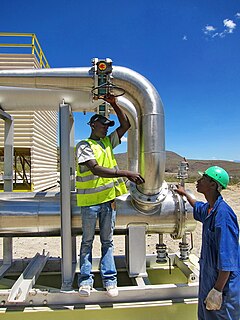
Renewable energy is energy that is collected from renewable resources that are naturally replenished on a human timescale. It includes sources such as sunlight, wind, rain, tides, waves, and geothermal heat. Although most renewable energy sources are sustainable, some are not. For example, some biomass sources are considered unsustainable at current rates of exploitation.

Due to the geological location of Iceland, the high concentration of volcanoes in the area is often an advantage in the generation of geothermal energy, the heating and making of electricity. During winter, pavements near these areas are heated up.

Geothermal energy is the thermal energy in the Earth's crust which originates from the formation of the planet and from radioactive decay of materials in currently uncertain but possibly roughly equal proportions. The high temperature and pressure in Earth's interior cause some rock to melt and solid mantle to behave plastically. This results in parts of the mantle convecting upward since it is lighter than the surrounding rock. Temperatures at the core–mantle boundary can reach over 4000 °C (7200 °F).

Renewable energy in Portugal was the source for 25.7% of total energy consumption in 2013. In 2014, 27% of Portugal's energy needs were supplied by renewable sources. In 2016, 28% of final energy consumption in Portugal came from renewable sources.

Iceland is a world leader in renewable energy. 100% of Iceland's electricity grid is produced from renewable resources. In terms of total energy supply, 85% of the total primary energy supply in Iceland is derived from domestically produced renewable energy sources. Geothermal energy provided about 65% of primary energy in 2016, the share of hydropower was 20%, and the share of fossil fuels was 15%.

Geothermal energy in the United States was first used for electric power production in 1960. The Geysers in Sonoma and Lake counties, California was developed into the largest geothermal steam electrical plant in the world, at 1,517 megawatts. Other geothermal steam fields operate in the western US and Alaska.

Renewable energy in the United Kingdom can be divided into production for electricity, heat, and transport.

Geothermal power is electrical power generated from geothermal energy. Technologies in use include dry steam power stations, flash steam power stations and binary cycle power stations. Geothermal electricity generation is currently used in 26 countries, while geothermal heating is in use in 70 countries.

Energy in Mexico describes energy and electricity production, consumption and import in Mexico.

Geothermal exploration began in China in the 1970s. It was initially handled by national bodies with public investments, and productive wells were transferred free of charge to the final user. Since the mid-1990s, under the framework of privatization and liberalization of the economy, national investment in exploration has been reduced. No new plants have been commissioned in the period 2000–2005. The only electricity-producing fields are located in Tibet. According to the "2005 Chinese Geothermal Environment Bulletin" by China's Ministry of Land and Resources, the direct utilization of geothermal energy in China will reach 13.76 cubic meters per second, and the geothermal energy will reach 10,779 megawatts, ranking first in the world.

The climate of Turkey and its geography are very suitable for solar energy, and it is a growing part of renewable energy in the country, with almost 8 GW of solar panels generating about 4% of the country's electricity. Solar potential is very high in Turkey, especially in the South Eastern Anatolia and Mediterranean provinces. Conditions for solar power generation are comparable to Spain. However, in 2020 Turkey ranked 8th in Europe for solar power. It could increase far more quickly if subsidies for coal were abolished and the auction system was improved. Every gigawatt of solar power installed would save over US$100 million on gas import costs.

Geothermal power is very cost-effective in the Great Rift Valley of Kenya, East Africa. As of 2019, Kenya has 690 MW of installed geothermal capacity. Kenya was the first African country to build geothermal energy sources. The Kenya Electricity Generating Company, which is 74% state-owned, has built three plants to exploit the Olkaria geothermal resource, Olkaria I, Olkaria II and Olkaria IV, Olkaria V, 75 MW Wellhead generation plants, with a third private plant Olkaria III. Additionally, a pilot wellhead plant of 2.5 MW has been commissioned at Eburru and two small scale plants have been built by the Oserian Development Company to power their rose farm facilities with a total of 4 MW.
South Australia has a variety of natural energy sources. It contains significant reserves of fossil fuels such as natural gas, coal, and oil – although there are incentives to phase these out in favour of clean energy. The state also contains large amounts of uranium, including the world's single biggest deposit at Olympic Dam, which represents 30% of the world's total resource. There are also expanses of land suitable for solar and wind farms, and rocks with potential for geothermal energy.
The Kızıldere Geothermal Power Plant is a geothermal power plant located at Kızıldere village of Sarayköy district in Denizli Province, southwestern Turkey. The initial power plant with 15 MW installed capacity was expanded in the second phase about 80 MW to 95 MW in total, making the facility Turkey's biggest geothermal power plant. It is planned to expand the power plant in a third and fourth phase.

Although there are plenty of renewable resources for energy in Turkey, only hydropower has been much developed, averaging about a fifth of national electricity supply. However, because this is vulnerable to droughts, less electricity than usual is from hydro in those recent years, compared to around a third in a wet year. Over half of capacity is renewables and it is estimated that over half of generation could be from renewables by 2026 but Turkey has invested less in solar and wind power than similar Mediterranean countries. Turkey needs a renewable energy plan beyond 2023 which includes transport, industry, heating and cooling as well as electricity generation. Turkey is a net exporter of wind power equipment but a net importer of solar power equipment.

Turkey uses more electricity per person than the global average but less than the European average, with demand peaking in summer due to air conditioning. Most electricity is generated from coal, gas and hydropower. The hydroelectricity from the east is transmitted to big cities in the west. Electricity prices are state-controlled, but wholesale prices are heavily influenced by the cost of imported gas.

By the end of 2016 Austria already fulfilled their EU Renewables Directive goal for the year 2020. By 2016 renewable energies accounted to 33.5% of the final energy consumption in all sectors. The renewable energy sector is also accountable for hosting 41,591 jobs and creating a revenue of 7,219 million euros in 2016.
As of 2021 there was little renewable energy in Belarus but a lot of potential. 7% of primary energy in Belarus was from renewables in 2019, mostly biofuels. As there is a lot of district heating more renewables could be integrated into that, but this is hindered by fossil fuel subsidies.
















